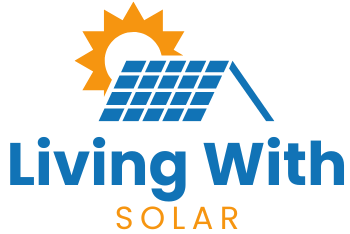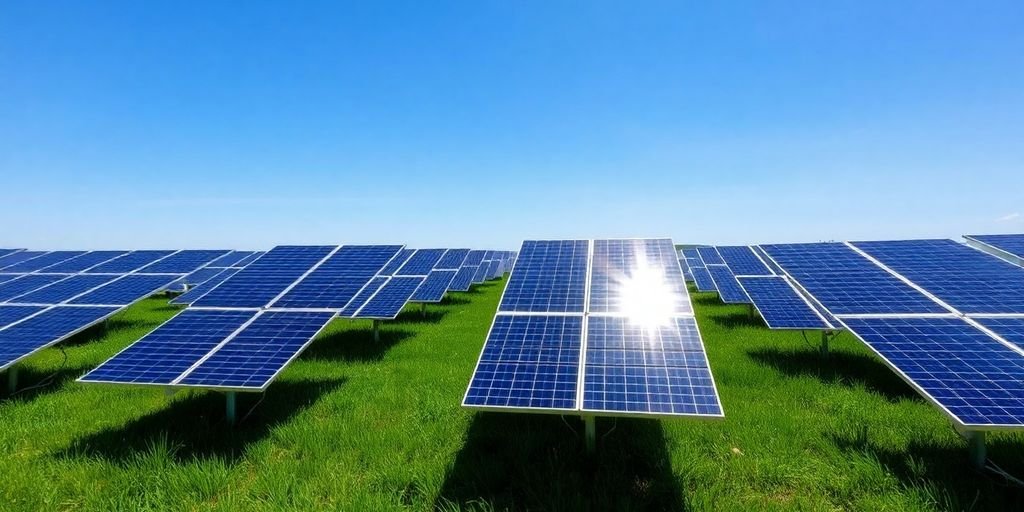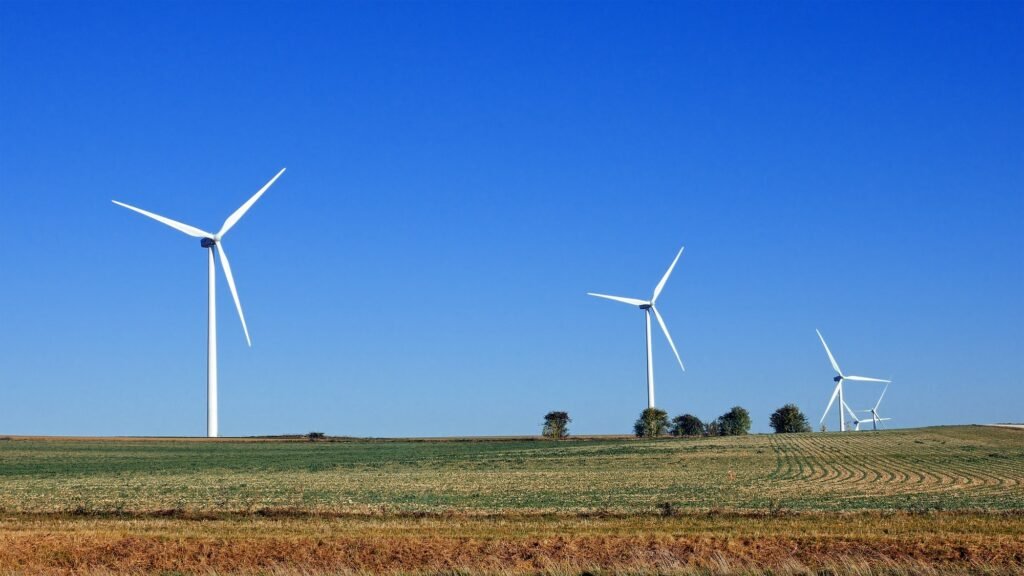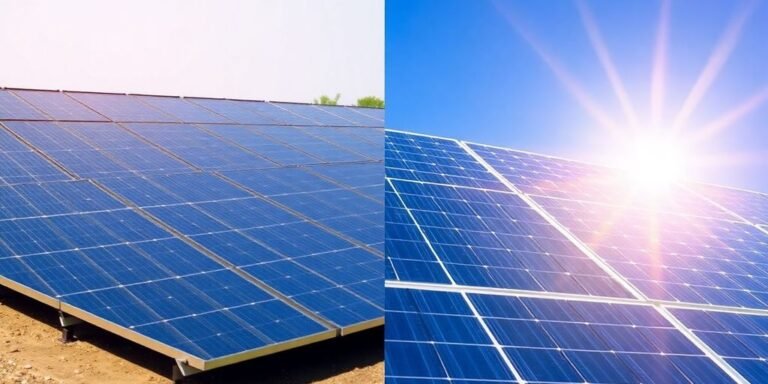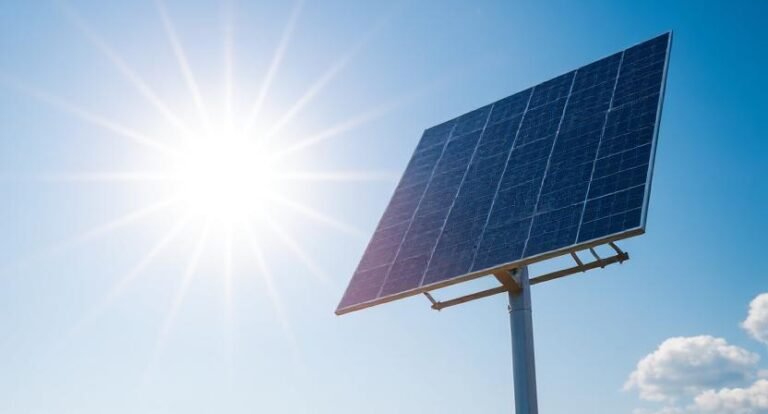Thinking about going solar? You may imagine panels on a roof, but that’s not your only option. Ground mount solar panels are a good option if your roof isn’t suitable or if you just don’t want your roof to be covered in solar panels. They operate slightly differently and have their pros and cons.
This guide will explain everything about ground mount solar panels, how they work, and what you need to install them so you can determine whether they’re a fit for your home.
Key Takeaways
- The ground mount solar panels sit on the ground — they’re not mounted to your rooftop — so you can choose where they’re placed.
- These systems can occasionally be even more efficient than rooftop panels, because you can position them to maximize sun exposure.
- You must have an open area on your property for ground mount solar, as well as ground stability and a good quality of soil, as they factors into the installation.
- Ground mount solar panels can be more expensive to install than rooftop systems in some cases, despite the fact that they offer benefits.
- Be sure to double-check local rules and permits for ground-mounted systems; they can have different rules than those that apply to panels installed on rooftops.
What Exactly Are Ground-Mounted Solar Panels?

Ground-mounted solar panels are solar energy systems installed directly on the ground instead of the roof. They are mounted on metal racks or poles and can be adjusted for optimal sun exposure. Ideal for homes with shaded or unsuitable rooftops, ground-mounted systems offer flexibility in placement, angle, and size, often making them more efficient than roof-based systems.
So, ground-mounted solar panels, you say? Well, let me tell you, it’s about what you’d expect. Not the ones you tack onto your roof; these are solar panels down on the ground, installed on special racks or poles. Would think of them as solar panels, but Julia Hammond did.
They’re built to catch the sun like their rooftop brethren, but they have their own configuration. I’ve noticed them on major open fields, and even in people’s backyards if said residents have the room to accommodate them. They require no building attachment, which makes for great flexibility of place and angle.
I’ve discovered that ground-mounted solar panels are a great option when your roof isn’t right for solar, or if you simply want more control over the panels’ orientation. They provide an alternative way to capture the sun’s energy, and for some properties, they are the practical option.
What separates them from Rooftop Panels?
When I first considered solar, I mostly imagined panels on roofs. But ground mounts are another beast entirely. Here are the aspects I found that make them stand out:
Location Flexibility: As long as they see enough sun, you can place them almost anywhere around your property, not just on your roof. That’s a big deal if your roof is shaded, irregularly shaped, etc.
Better Angling: Being on the ground, you can simply tilt or aim the panels to get the most sun throughout the day and even during different seasons. This can really amplify how much power they produce.
Maintenance Access: It’s much easier to clean and maintain since it doesn’t require you to get on the roof. I love the idea of walking right up to them.
Components of a Ground-Mounted System
It’s not just the panels themselves: It’s a whole system. As far as I can tell, it usually consists of:
- The Solar Panels: Duh, you will need these! They are exactly the kind of panels you would see on a roof, just rigged up differently.
- Racking or Mounting System: This holds the panels in place. It can be fixed or occasionally adjustable. This framework is essential for mounting solar panels.
- Foundation: They’re down to earth; they need to be grounded. This might be concrete footings, driven piles, or even ballasted systems that simply sit on the ground without any excavation.
- Inverter: The inverter provides AC electricity for your home from the DC produced by the panels.
- Wire and Electrical: Everything you need to effectively wire the system to your home’s electrical panel.
Ideal Scenarios for Ground Mounts
I’ve come to understand that ground mounts aren’t for everybody, but they’re just the ticket in some cases. For example:
- Homes with Lots of Land: If you have a large yard or even several acres, you have plenty of room to place these without them feeling squeezed in.
- Shaded or Complex Roofs: If your roof is shaded by trees or has a dozen vents, or is facing the wrong way, ground mounts solve that issue.
- Future Expansion: Typically, it is easier to expand a ground-mounted system with more panels than a rooftop system if you realize you need more power in the future. This makes it easier to install solar panel systems.
How Do Ground Mount Solar Panels Work?
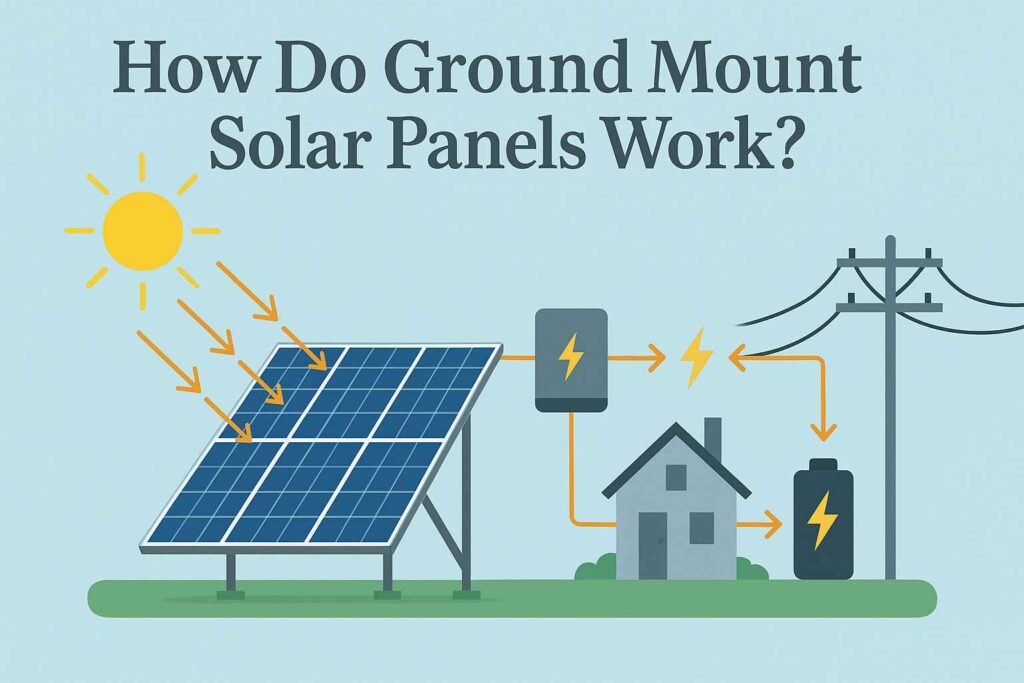
I’ve been getting a lot of requests for an explanation of how ground-mounted solar panels work, and it’s really a very simple process, much the same as for rooftop solar systems, but with a few key differences in how they are configured. The simple concept is that these panels harness sunlight and transform it into electricity, which can then power your home or be stored away for your use on a rainy day!
Think of it this way: sunlight shines on the photovoltaic (PV) cells in the panels. These cells consist of semiconductor materials, most commonly silicon. When solar photons hit these cells, they dislodge electrons from their atoms. This flow of electrons is an electric current. The current that flows is electricity in the form of direct current (DC).
Today, most homes and appliances run on alternating current (AC) electricity. So, the DC electricity generated by the panels is passed through an inverter, which converts it to the alternating current that is pumped into the grid.
From there, the AC electricity can be consumed directly in your home, stored in a battery storage system, or exported to the grid, or whatever it decides based on the home’s setup. For those looking to get solar panels installed on their roof, the basic process of generating electricity is the same.
“Ground-mounted systems are singularly gratifying to thrifty do-it-yourself or small contractors. Whereas rooftop panels are stuck going in the same orientation as the roof, a ground mount can be adjusted to find the most optimal angle to maximally intercept sunlight at every point in the day. That’s because they can usually produce more power, especially if you have a tracking system to move the panels as the sun moves. It’s all about getting the most out of the sun.”
– Sophia Green
For those interested in the latter, [Chris] has a similar blog post for an [off-grid solar ground install], though with more emphasis on battery storage to keep things running while the sun is down. And this rig will provide energy independence, which is very positive for a large number of people. You can’t fully appreciate the benefits of these systems until you first understand the way that solar works in general.
Types of Ground Mount Solar Systems
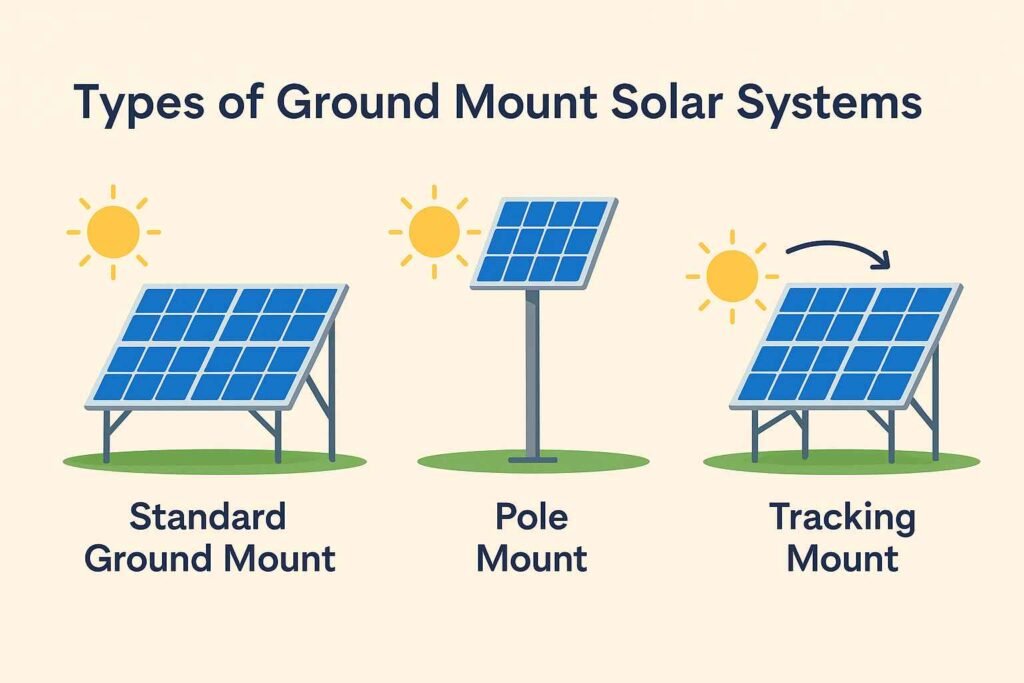
So when I began researching ground-mounted solar panels, I saw that it was not a one-size-fits-all situation. There are several different varieties of solar panel mounting systems, and they all come with their quirks and perks. It does depend on your land, your budget, and what you’re hoping to achieve with installing a solar array.
Standard Ground Mount
This is likely what most people envision when they hear the phrase ground-mounted solar. It is a metal frame, often driven into the ground, that holds solar panels at a fixed angle. That’s not too complicated, and while the angle is usually never changing, sometimes the orientation can be adjusted a few times a year.
This allows you to make adjustments so that they will capture more sun at different times of the year. It’s a good choice for a lot of people, in particular a rural solar installation where you’ve got a large space to work with.
Pole Mount
Now, a pole-mounted solar system is a little different. Instead of a frame resting close to the ground, your solar panels are hoisted up on one or more poles. This could be a great choice if the ground isn’t perfectly flat or if space is tight for you.
Toss in the fact that getting the panels farther off the ground can reduce the hassle of cleaning them. I’ve even heard of some people who pair these with a solar tracker installation, for some serious energy capture, but that’s the next type.
Tracking Mount
Now it gets interesting. Tracking mount: A mounting structure that seeks the sun automatically during a solar day. So your panels also stay at the right angle to soak in as much sunlight as possible. A standard fixed-tilt solar system is easier, though a tracking mount can up your output of energy in a big way.
It’s a more complicated configuration that typically comes with a higher upfront cost, but for a commercial ground-mount solar array or almost anyone who wants the highest efficiency, it can be a game-changer.
For the more financially minded among us, you can look at solar panel prices to get a better understanding of whether this is something that will fit within your budget. In addition to information about solar power basics that apply to most of these systems. And if you’re contemplating doing some of the work yourself, then a primer on how to install solar panels could be extremely valuable.
Cons of Ground-Based Solar Systems

I have written a lot about the good things concerning ground-mounted solar panels, so I feel it is only right to consider the bad, too. No system’s perfect, and these have some downsides you’re going to want to weigh before you decide if they’re right for you. You know, I try to come to it with an open mind and weigh all the pros and cons in a big decision like this, and solar is a big one.
Higher Upfront Costs
One of the first things I learned when I began researching ground-mounted systems was that they’re often even more expensive to install than rooftop panels. It stands to reason when you think about it. Your house, thanks to rooftop solar, is already there, supplying the structure. But with ground mounts, a whole new system of support must be raised.
That means more materials, more labor, and in some cases, more complicated engineering. The additional construction and foundation work is a significant boost to the overall price tag. And it’s not just the panels themselves; it’s also everything you will need to hold them up safely and plug them into your home’s electrical system. This can include things like:
- Dig holes for and pour concrete foundations.
- Fitting heavy-duty beaver-tailed racks that will last in all temperatures.
- Digging lengthened trenches for the electrical conduits that will run from the panels to the main electrical panel in your home.
- Possibly requiring additional, specialized tooling for the installation.
“Long-term savings on solar are awesome, but the initial investment on ground mounts can be a barrier for folks, I’ve found. It is important when considering solar to budget for these additional costs and not just look at the cost of the panels themselves.”
– Sophia Green
Land Requirement and Aesthetic Value
This one is a big one for me, especially since I don’t have a ton of yard. Ground-mounted solar panels take up a lot of space. They can’t just be shunted off into a corner; they require open, unobstructed space in order to function effectively. This means you’re and you’re dedicating a substantial part of your real estate on your property to the solar array.
You might not care about this, and it may not matter if you have lots of land to roam. But for the others, it can also mean giving up yards of garden space, play areas, perhaps even that future expansion that you envisioned initially. The land needs of solar panels are pretty specific and can affect how you use your outdoor space.
Before installing any solar system—especially ground-mounted panels—it’s crucial to evaluate your property. From sunlight exposure to land availability, this guide walks you through what to assess before making the switch.
Read the Suitability Checklist →- They do chew up a lot of yard space that could have a better purpose.
- Aesthetically, they are quite visible, which can bother some homeowners.
You might have to cut down trees or other obstacles for adequate sunlight, which can be an extra expense and an inconvenience.
Red Tape: Allowing and Zoning Issues
I’ve read about how difficult it can be to get permitting for any type of solar installation, but it sounds like ground mounts can be an extra layer of hassle in some cases. Because they’re a separate structure, they can be subject to different zoning rules than rooftop systems. This could mean more red tape, more inspections, and even longer waiting times for approval.
Thinking about installing ground-mounted solar panels? Explore the full list of advantages and potential downsides of solar energy so you can make a smart, informed decision.
View the Full Pros & Cons →Certain homeowner’s associations (HOAs) might also have stricter guidelines or may simply not allow ground-mounted systems because of aesthetics or lack of yard space. It’s something I would be researching early if I were in your position. Knowing the advantages and disadvantages of solar energy in your region is an important factor.
Growing Vulnerability to Attack and Risk Requirements
Ground-mounted systems are more accessible than rooftops, since most of us don’t have access to our roofs. But the accessibility that makes them easy to maintain can also make them more susceptible to some hazards. I have processed things like:
- Vandalism: They are more easily accessible at ground level for purposeful damage.
- Animal Interference: Animals such as rodents and perhaps more significant animals may chew on wires or interfere with transmitters.
- Accidental damage: Lawnmowers, falling branches, or the kids kicking a ball can cause accidental damage to panels or wiring.
It’s something to think about, especially if you live in an area with abundant wildlife or if your property is not completely enclosed. You may also have to spend some money to create added security, such as by installing fencing, so that could also increase the cost, but also potentially the aesthetic. When you’re thinking about how solar panels produce electricity, well, you want to keep them safe.
Installation Requirements for Ground-Mounted Systems
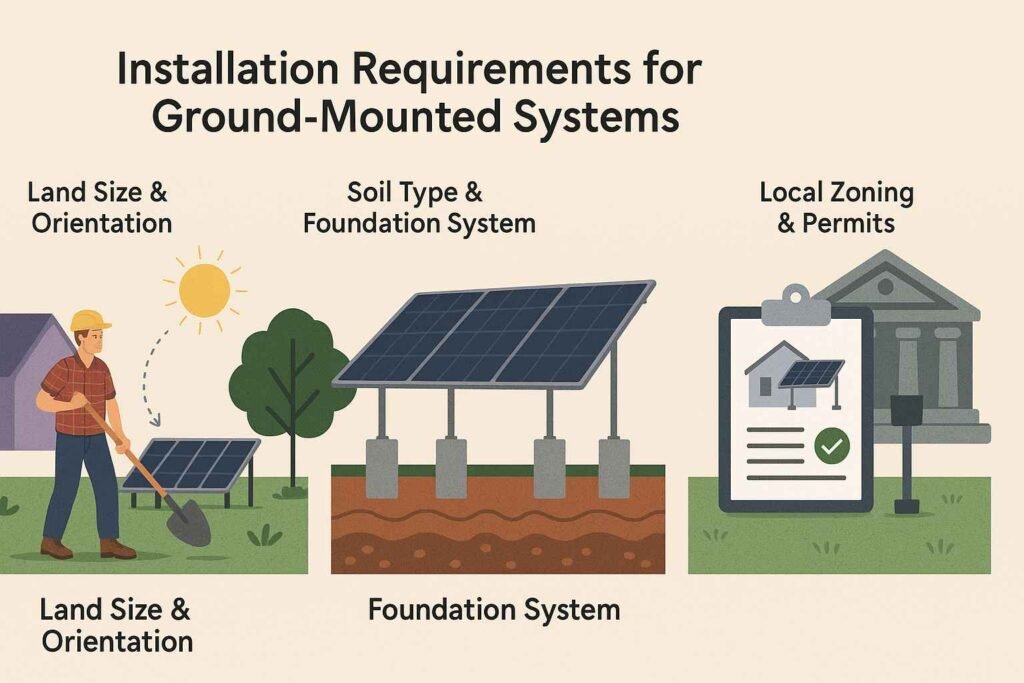
When I began to research ground-mounted solar panels, though, I learned that it wasn’t as simple as simply choosing a few panels and planting them in a patch of grass. There are a number of decisions you need to make before you even think about getting a shovel in the ground.
It’s a bit more complicated than slapping a bunch on a roof, that’s for sure. You know, you are essentially building a small power plant in your backyard, so you have some real practicalities to think about.
Land Size & Orientation
First off, you need space. And space, not just any space, but the right kind of space. You’ll want a fair amount of open land that receives abundant sunshine over the course of the day. I learned that the best patch is typically one that is oriented south, particularly if you are in the Northern Hemisphere, as that is where you will have the greatest chance of direct sunlight. But direction is not the only thing to consider; you also need to consider shadows.
Do you have large trees, your house, or a neighbor’s shed that could shade your panels at some point during the day or year? Even a little shade can seriously lower the amount of power your panels generate. I also discovered setback requirements based upon property lines that can determine how near to your fence or road you can build.
“It’s a matter of finding that sweet spot between giving them enough space and giving them maximized sun exposure. If you are worried whether your property is good for solar, then homeowners and businesses should make a comprehensive review of these factors before going for the full solar installation.
Soil Type & Foundation System
This one surprised me a little. I thought you just plop holes in the ground and put up posts, but there’s more to it than that. The quality of your soil is a huge deal because the type of foundation you’ll need to hold up those panels is also determined by the condition of your soil. The last thing you want is for your costly solar rig to start sinking, or to start leaning over, either of which would probably happen amid some seriously bad weather.
I learned about the various types of foundations, ways you could have been founded—concrete piers, driven piles, or even ballasted systems that just sit on the ground with weights. The best choice is going to be very dependent on your soil – whether it is sandy, clay, rocky, etc. Occasionally, you’ll even need a soil test to determine what’s going to work best, and make sure your system has a reliable base. This is pretty important for the long-term stability of your system.
I’ve realized that the foundation is not only about supporting the panels; it’s about keeping them perfectly aligned and secured for decades. It’s an essential part of the system’s overall integrity, and any compromise on this can cause big problems later on.
Local Zoning & Permits
Here’s where we go a little down the rabbit hole of bureaucracy, but for good reason. Before you so much as pick up a shovel, you’ll need to consult with your local planning office about zoning regulations and permits. Every town or county seems to have its rules about what you can build and where.
I’ve heard tales of people halfway through an installation realizing they didn’t have the proper permits, and then incurring costs or tearing things down. You may be required to have permits to do the electrical work, for the structural foundation, or even just for the general construction. (You’ll want to have all your ducks in a row here.) Knowing how the solar panel system installation process works with permits is important for a smooth project. This often involves:
- Provide detailed designs for your proposed system.
- Getting the building and electrical departments to sign off.”
- Dealing (possibly, miles will vary here) with homeowner association (HOA) rules if you have one.
It may seem like there is a lot of paperwork, but it is all part of ensuring your ground-mounted solar system is safe, up to code, and isn’t the source of any headaches down the road. It’s also worth considering whether a solar array is even possible at your home from a regulatory perspective.
Are Ground-Mounted Panels More Efficient Than Rooftop
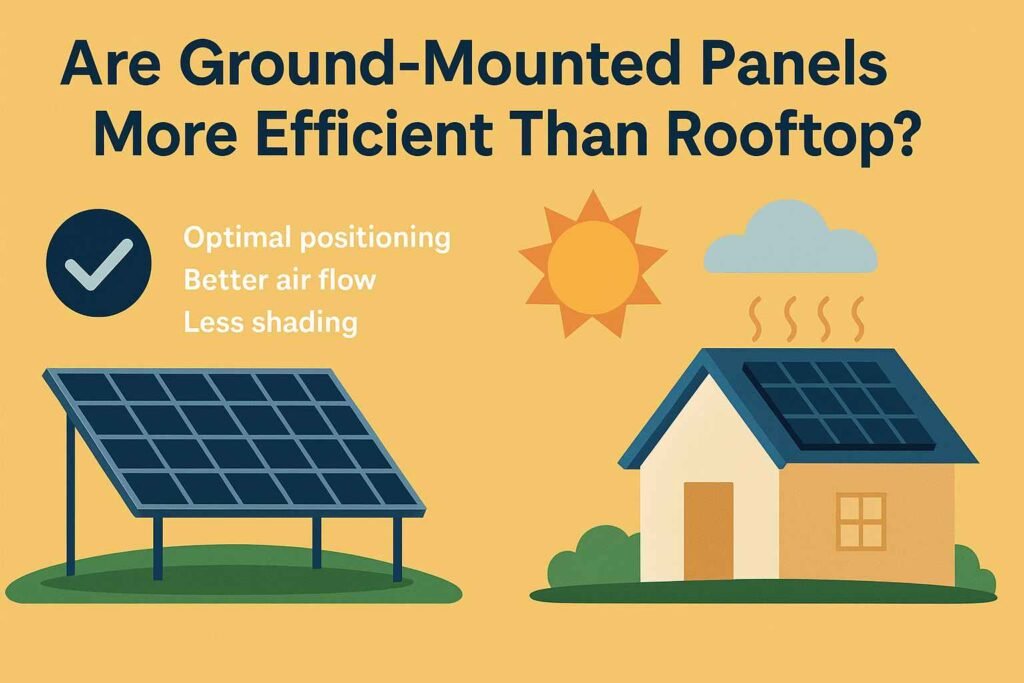
When I consider solar panels, one of my biggest questions is whether a ground-mounted system will produce more power than a roof-mounted one. It’s not just about sticking panels anywhere; it’s about getting the most from them. Ground-mounted panels also tend to enjoy an efficiency advantage because they can be positioned with much more freedom for the best angle and air flow.
A significant reason why ground mounts can potentially be more efficient is that you can position them towards the sun optimally. When you install a rooftop system, you’re at the mercy of whatever angle your roof happens to be sitting at.
Curious how rooftop installations differ from ground-mounted setups? This step-by-step guide covers permits, site inspection, mounting, wiring, and activation — giving you a complete picture of the solar installation process.
See the Installation Process →With ground mounts, however, I can position the tilt and orientation just right to get the most sun exposure throughout the day. That’s more energy production, especially if I am somewhere where the sun changes direction significantly with the seasons.
Another way in which ground-mounted panels have it better: the flow of air around them. Cool panels work better. Rooftop panels are also fairly close to the roof, which can also trap heat. Ground-mounted systems, however, typically have ample room beneath and around the panels for free air flow. This keeps them cooler and enables them to work at their optimum.
And I’ve learned that even tiny variations in temperature and angle can mean a whole lot more electricity over the long run. The presence of panels isn’t enough; they need to be in the right place to perform and do their job well, too.
Here’s a brief checklist of some of the factors that affect efficiency:
- Perfect Tilt and Azimuth: Ground structures capable of being tilted and adjusted to the appropriate angle to receive the most sunlight based on seasonal changes.
- Air Flow: Improved air flow around ground-mounted panels keeps temperatures lower and increases efficiency.
- Crosses to Watch For Shading Avoidance; It’s usually more manageable to avoid shade from trees or other structures with ground mounts, simply because I have more control of their respective position.
- Maintenance Access: As you may know, dust and dirt may tend to accumulate on panels; easier cleaning and less dust and dirt are possible with ground-mounted panels.
If pulling out all the stops for my solar system’s efficiency is my primary objective, rooftop panels are great, but ground mounts can sometimes edge them out because of these efficiencies.
How much do ground-mounted solar panels cost

One of the first things I wanted to know when I began researching ground-mounted solar panels, of course, was the cost. This is a big investment, so you need to understand the financial aspect. Ground-mounted solar panels can come with a wide range of costs, though, in general, they are a little pricier than their rooftop counterparts.
Wondering what it really costs to go solar? Get the full breakdown of panel pricing, labor, permits, and long-term value in our detailed guide.
Read the Full Cost Guide →I’ve discovered this is primarily because you require additional gear and labor for the ground (although you should not require concrete), such as special mounting systems and, in some cases , trenching for the wiring.
I have learned that the initial cost for ground-mounted systems can be higher, but the long-term savings on electricity bills make them a really good investment. It’s really all about weighing the upfront cost with the possibility for added energy production and independence.
Here we will dissect some of the aspects that contribute to a ground-mounted system’s total solar panel cost:
- System Size: Probably the largest factor. The more power you want, the more panels you will need, and, in theory, the more it will cost. A bigger system requires greater materials and more time to install.
- Mounting Structure Type: As I noted above, there are the standard, pole, and tracking types of ground mounts. Tracking mounts, although the most effective, are also the most expensive because of their intricate mechanics.
- Costs Vary: but few new homes are built without extra costs associated with the land, such as excavation, clearing, grading, or foundation work. Knappe states that rocky soil or bumpy land can drive up the general cost of labor and materials.
- Cost of Labor: This is a factor influenced by your location. Solar installer labor market rates can vary quite a bit from region to region. I’ve observed that solar panel prices by state can differ substantially.
- Permits and Inspections: Solar installations are subject to local jurisdiction controls, and rules and costs vary everywhere. Negotiating the required permits and inspections is non-negotiable and will add to the total cost.
- Extra Equipment: Inverters, energy storage batteries and high-tech monitoring equipment will also affect the end cost. If you’re looking for energy independence, a battery backup system will tack a lot more onto your solar panel installation cost.
Here’s a rough idea of how the costs might break down, but keep in mind these are just averages and can vary dramatically based on the factors listed above:
| System Size (kW) | Estimated Price Range (Before Incentives) |
|---|---|
| 5 kW | $15,000 – $25,000 |
| 10 kW | $25,000 – $40,000 |
| 15 kW | $35,000 – $55,000 |
These numbers are only an introduction to the ground mount solar cost. For an exact figure in your specific situation, it’s always a good idea to get a few quotes from a number of installers.
Frequently Asked Questions
What are ground-mounted solar panels?
Ground-mounted solar panels are solar panels that are installed on the ground rather than on a roof. They are erected on special frames or masts that are buried in the ground. This allows them to be angled just right to catch the most sun.
Do ground-mounted solar panels use the sun more effectively?
Yes, they can be! Ground-mounted panels can be angled to the optimal position to catch the sun at various times of the year, and as such, they typically produce more electricity than rooftop panels, which are fixed in place.
What does it cost to install ground-mounted solar panels?
The cost can change a lot. It all depends on how many panels you would require, what sort of mounting system, and how much preparation work your land requires. In general, up front, they may also be more expensive than rooftop systems because they involve additional digging and installation.
Should I install ground-mounted solar panels?
You’ll need a lot of open space that sees plenty of sun all day long. There are a lot of ifs based on these numbers, of course: The ground needs to be stable enough to carry the mounts, and local authorities are likely to have rules, or at least require permits.
When is ground-mounted solar the right choice?
If your roof doesn’t work for solar panels (perhaps it’s too small, too old, or in too much shade), ground-mounted systems are wonderful. They’re also good if you have ample space and want to produce the maximum amount of electricity.
What types of ground-mounted solar systems are available?
Most common are standard ground mounts, which are fixed, and pole mounts, which elevate panels higher on one pole. There are also tracking mounts that continually move to stay pointed at the sun, and they’re even more efficient.
